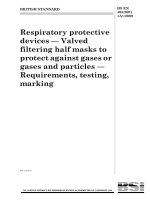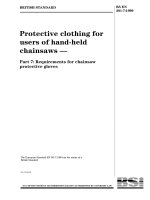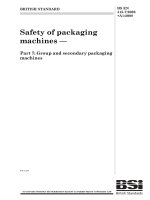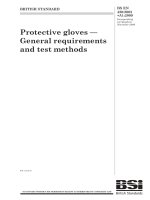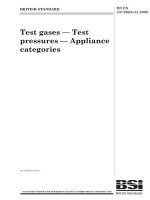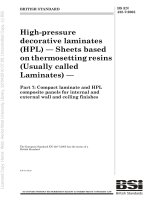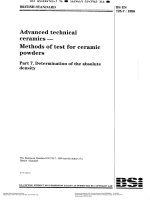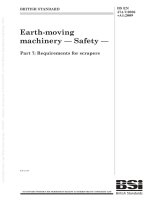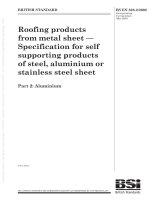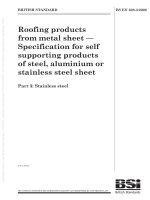Bsi bs en 61850 7 420 2009
Bạn đang xem bản rút gọn của tài liệu. Xem và tải ngay bản đầy đủ của tài liệu tại đây (2.62 MB, 106 trang )
BS EN 61850-7-420:2009
BSI British Standards
Communication networks
and systems for power utility
automation —
Part 7-420: Basic communication structure —
Distributed energy resources logical nodes
NO COPYING WITHOUT BSI PERMISSION EXCEPT AS PERMITTED BY COPYRIGHT LAW
raising standards worldwide™
BRITISH STANDARD
BS EN 61850-7-420:2009
National foreword
This British Standard is the UK implementation of EN 61850-7-420:2009. It is
identical to IEC 61850-7-420:2009.
The UK participation in its preparation was entrusted to Technical Committee
PEL/57, Power systems management and associated information exchange.
A list of organizations represented on this committee can be obtained on
request to its secretary.
This publication does not purport to include all the necessary provisions of a
contract. Users are responsible for its correct application.
© BSI 2009
ISBN 978 0 580 56442 0
ICS 33.200
Compliance with a British Standard cannot confer immunity from
legal obligations.
This British Standard was published under the authority of the Standards
Policy and Strategy Committee on 31 July 2009
Amendments issued since publication
Amd. No.
Date
Text affected
BS EN 61850-7-420:2009
EUROPEAN STANDARD
EN 61850-7-420
NORME EUROPÉENNE
June 2009
EUROPÄISCHE NORM
ICS 33.200
English version
Communication networks and systems for power utility automation Part 7-420: Basic communication structure Distributed energy resources logical nodes
(IEC 61850-7-420:2009)
Systèmes et réseaux de communication
pour l'automatisation des services
de distribution d'énergie Partie 7-420: Structure
de communication de base Nœuds logiques de ressources
d'énergie distribuées
(CEI 61850-7-420:2009)
Kommunikationsnetze und -systeme
für die Automatisierung
in der elektrischen Energieversorgung Teil 7-420: Grundlegende
Kommunikationsstruktur Logische Knoten für die
dezentrale Energieversorgung
(IEC 61850-7-420:2009)
This European Standard was approved by CENELEC on 2009-05-01. CENELEC members are bound to comply
with the CEN/CENELEC Internal Regulations which stipulate the conditions for giving this European Standard
the status of a national standard without any alteration.
Up-to-date lists and bibliographical references concerning such national standards may be obtained on
application to the Central Secretariat or to any CENELEC member.
This European Standard exists in three official versions (English, French, German). A version in any other
language made by translation under the responsibility of a CENELEC member into its own language and notified
to the Central Secretariat has the same status as the official versions.
CENELEC members are the national electrotechnical committees of Austria, Belgium, Bulgaria, Cyprus, the
Czech Republic, Denmark, Estonia, Finland, France, Germany, Greece, Hungary, Iceland, Ireland, Italy, Latvia,
Lithuania, Luxembourg, Malta, the Netherlands, Norway, Poland, Portugal, Romania, Slovakia, Slovenia, Spain,
Sweden, Switzerland and the United Kingdom.
CENELEC
European Committee for Electrotechnical Standardization
Comité Européen de Normalisation Electrotechnique
Europäisches Komitee für Elektrotechnische Normung
Central Secretariat: Avenue Marnix 17, B - 1000 Brussels
© 2009 CENELEC -
All rights of exploitation in any form and by any means reserved worldwide for CENELEC members.
Ref. No. EN 61850-7-420:2009 E
BS EN 61850-7-420:2009
EN 61850-7-420:2009
-2-
Foreword
The text of document 57/981/FDIS, future edition 1 of IEC 61850-7-420, prepared by IEC TC 57, Power
systems management and associated information exchange, was submitted to the IEC-CENELEC
parallel vote and was approved by CENELEC as EN 61850-7-420 on 2009-05-01.
The following dates were fixed:
– latest date by which the EN has to be implemented
at national level by publication of an identical
national standard or by endorsement
(dop)
2010-02-01
– latest date by which the national standards conflicting
with the EN have to be withdrawn
(dow)
2012-05-01
Annex ZA has been added by CENELEC.
__________
Endorsement notice
The text of the International Standard IEC 61850-7-420:2009 was approved by CENELEC as a European
Standard without any modification.
In the official version, for Bibliography, the following notes have to be added for the standards indicated:
IEC 60364-7-712
NOTE Harmonized as HD 60364-7-712:2005 (not modified).
IEC 60870-5-101
NOTE Harmonized as EN 60870-5-101:2003 (not modified).
IEC 60870-5-104
NOTE Harmonized as EN 60870-5-104:2006 (not modified).
IEC 61800-4
NOTE Harmonized as EN 61800-4:2003 (not modified).
IEC 61850
NOTE Harmonized in EN 61850 series (not modified).
IEC 61850-6
NOTE Harmonized as EN 61850-6:2004 (not modified).
IEC 61850-7-1
NOTE Harmonized as EN 61850-7-1:2003 (not modified).
IEC 61850-8
NOTE Harmonized in EN 61850-8 series (not modified).
IEC 61850-9
NOTE Harmonized in EN 61850-9 series (not modified).
IEC 61850-10
NOTE Harmonized as EN 61850-10:2005 (not modified).
IEC 61968
NOTE Harmonized in EN 61968 series (not modified).
IEC 61970-301
NOTE Harmonized as EN 61970-301:2004 (not modified).
IEC 62056
NOTE Harmonized in EN 62056 series (not modified).
ISO/IEC 7498-1
NOTE Harmonized as EN ISO/IEC 7498-1:1995 (not modified).
__________
BS EN 61850-7-420:2009
-3-
EN 61850-7-420:2009
Annex ZA
(normative)
Normative references to international publications
with their corresponding European publications
The following referenced documents are indispensable for the application of this document. For dated
references, only the edition cited applies. For undated references, the latest edition of the referenced
document (including any amendments) applies.
NOTE When an international publication has been modified by common modifications, indicated by (mod), the relevant EN/HD
applies.
Publication
Year
Title
EN/HD
Year
IEC 61850-7-2
2003
Communication networks and systems in
substations Part 7-2: Basic communication structure for
substation and feeder equipment - Abstract
communication service interface (ACSI)
EN 61850-7-2
2003
IEC 61850-7-3
2003
Communication networks and systems in
substations Part 7-3: Basic communication structure for
substation and feeder equipment - Common
data classes
EN 61850-7-3
2003
IEC 61850-7-4
2003
Communication networks and systems in
EN 61850-7-4
substations Part 7-4: Basic communication structure for
substation and feeder equipment - Compatible
logical node classes and data classes
2003
IEC 61850-7-410
-
1)
Communication networks and systems for
power utility automation Part 7-410: Hydroelectric power plants Communication for monitoring and control
EN 61850-7-410
2007
ISO 4217
-
1)
Codes for the representation of currencies
and funds
-
-
1)
Undated reference.
2)
Valid edition at date of issue.
www.bzfxw.com
2)
–2–
BS EN 61850-7-420:2009
61850-7-420 © IEC:2009(E)
CONTENTS
FOREWORD...........................................................................................................................7
INTRODUCTION.....................................................................................................................9
1
Scope ............................................................................................................................. 12
2
Normative references ..................................................................................................... 12
3
Terms, definitions and abbreviations .............................................................................. 13
4
3.1 Terms and definitions ............................................................................................ 13
3.2 DER abbreviated terms ......................................................................................... 18
Conformance .................................................................................................................. 20
5
Logical nodes for DER management systems ................................................................. 20
5.1
Overview of information modelling (informative) .................................................... 20
5.1.1 Data information modelling constructs ....................................................... 20
5.1.2 Logical devices concepts ........................................................................... 21
5.1.3 Logical nodes structure ............................................................................. 22
5.1.4 Naming structure ....................................................................................... 22
5.1.5 Interpretation of logical node tables ........................................................... 23
5.1.6 System logical nodes LN Group: L (informative) ...................................... 24
5.1.7 Overview of DER management system LNs ............................................... 27
5.2 Logical nodes for the DER plant ECP logical device .............................................. 29
5.2.1 DER plant electrical connection point (ECP) logical device
(informative) .............................................................................................. 29
5.2.2 LN: DER plant corporate characteristics at the ECP Name: DCRP ............. 31
5.2.3 LN: Operational characteristics at ECP Name: DOPR ................................ 31
5.2.4 LN: DER operational authority at the ECP Name: DOPA............................ 32
5.2.5 LN: Operating mode at ECP Name: DOPM ................................................ 33
5.2.6 LN: Status information at the ECP Name: DPST ........................................ 34
5.2.7 LN: DER economic dispatch parameters Name: DCCT .............................. 35
5.2.8 LN: DER energy and/or ancillary services schedule control Name:
DSCC ........................................................................................................ 36
5.2.9 LN: DER energy and/or ancillary services schedule Name: DSCH ............. 37
5.3 Logical nodes for the DER unit controller logical device ........................................ 38
5.3.1 DER device controller logical device (informative) ..................................... 38
5.3.2 LN: DER controller characteristics Name: DRCT........................................ 38
5.3.3 LN: DER controller status Name: DRCS .................................................... 39
5.3.4 LN: DER supervisory control Name: DRCC ................................................ 40
Logical nodes for DER generation systems..................................................................... 42
www.bzfxw.com
6
6.1
6.2
6.3
Logical nodes for DER generation logical device ................................................... 42
6.1.1 DER generator logical device (informative) ................................................ 42
6.1.2 LN: DER unit generator Name: DGEN ....................................................... 42
6.1.3 LN: DER generator ratings Name: DRAT ................................................... 44
6.1.4 LN: DER advanced generator ratings Name: DRAZ ................................... 45
6.1.5 LN: Generator cost Name: DCST ............................................................... 46
Logical nodes for DER excitation logical device..................................................... 47
6.2.1 DER excitation logical device (informative) ................................................ 47
6.2.2 LN: Excitation ratings Name: DREX ........................................................... 47
6.2.3 LN: Excitation Name: DEXC ...................................................................... 48
Logical nodes for DER speed/frequency controller ................................................ 49
BS EN 61850-7-420:2009
61850-7-420 © IEC:2009(E)
7
–3–
6.3.1 Speed/frequency logical device (informative) ............................................. 49
6.3.2 LN: Speed/Frequency controller Name: DSFC ........................................... 49
6.4 Logical nodes for DER inverter/converter logical device ........................................ 50
6.4.1 Inverter/converter logical device (informative)............................................ 50
6.4.2 LN: Rectifier Name: ZRCT ......................................................................... 51
6.4.3 LN: Inverter Name: ZINV ........................................................................... 53
Logical nodes for specific types of DER .......................................................................... 55
7.1
Logical nodes for reciprocating engine logical device ............................................ 55
7.1.1 Reciprocating engine description (informative) .......................................... 55
7.1.2 Reciprocating engine logical device (informative) ...................................... 55
7.1.3 LN: Reciprocating engine Name: DCIP ...................................................... 56
7.2 Logical nodes for fuel cell logical device................................................................ 57
7.2.1 Fuel cell description (informative) .............................................................. 57
7.2.2 Fuel cell logical device (informative) .......................................................... 59
7.2.3 LN: Fuel cell controller Name: DFCL.......................................................... 60
7.2.4 LN: Fuel cell stack Name: DSTK ................................................................ 61
7.2.5 LN: Fuel processing module Name: DFPM................................................. 62
7.3 Logical nodes for photovoltaic system (PV) logical device ..................................... 63
7.3.1 Photovoltaic system description (informative) ............................................ 63
7.3.2 Photovoltaics system logical device (informative) ...................................... 65
7.3.3 LN: Photovoltaics module ratings Name: DPVM......................................... 67
7.3.4 LN: Photovoltaics array characteristics Name: DPVA................................. 68
7.3.5 LN: Photovoltaics array controller Name: DPVC ........................................ 69
7.3.6 LN: Tracking controller Name: DTRC ......................................................... 70
7.4 Logical nodes for combined heat and power (CHP) logical device ......................... 72
7.4.1 Combined heat and power description (informative)................................... 72
7.4.2 Combined heat and power logical device (informative) .............................. 75
7.4.3 LN: CHP system controller Name: DCHC................................................... 76
7.4.4 LN: Thermal storage Name: DCTS ............................................................ 77
7.4.5 LN: Boiler Name: DCHB ............................................................................ 78
Logical nodes for auxiliary systems ................................................................................ 78
www.bzfxw.com
8
8.1
8.2
8.3
8.4
8.5
Logical nodes for fuel system logical device .......................................................... 78
8.1.1 Fuel system logical device (informative) .................................................... 78
8.1.2 LN: Fuel characteristics Name: MFUL........................................................ 80
8.1.3 LN: Fuel delivery system Name: DFLV....................................................... 80
Logical nodes for battery system logical device ..................................................... 81
8.2.1 Battery system logical device (informative) ................................................ 81
8.2.2 LN: Battery systems Name: ZBAT.............................................................. 82
8.2.3 LN: Battery charger Name: ZBTC ............................................................. 83
Logical node for fuse device .................................................................................. 84
8.3.1 Fuse logical device (informative) ............................................................... 84
8.3.2 LN: Fuse Name: XFUS .............................................................................. 84
Logical node for sequencer ................................................................................... 85
8.4.1 Sequencer logical device ........................................................................... 85
8.4.2 LN: Sequencer Name: FSEQ ..................................................................... 85
Logical nodes for physical measurements ............................................................. 86
8.5.1 Physical measurements (informative) ........................................................ 86
8.5.2 LN: Temperature measurements Name: STMP .......................................... 86
–4–
9
BS EN 61850-7-420:2009
61850-7-420 © IEC:2009(E)
8.5.3 LN: Pressure measurements Name: MPRS................................................ 87
8.5.4 LN: Heat measured values Name: MHET ................................................... 87
8.5.5 LN: Flow measurements Name: MFLW ...................................................... 88
8.5.6 LN: Vibration conditions Name: SVBR ....................................................... 90
8.5.7 LN: Emissions measurements Name: MENV .............................................. 90
8.5.8 LN: Meteorological conditions Name: MMET .............................................. 91
8.6 Logical nodes for metering .................................................................................... 91
8.6.1 Electric metering (informative) ................................................................... 91
DER common data classes (CDC) .................................................................................. 92
9.1
Array CDCs ........................................................................................................... 92
9.1.1 E-Array (ERY) enumerated common data class specification ..................... 92
9.1.2 V-Array (VRY) visible string common data class specification .................... 92
9.2 Schedule CDCs ..................................................................................................... 93
9.2.1 Absolute time schedule (SCA) settings common data class
specification .............................................................................................. 93
9.2.2 Relative time schedule (SCR) settings common data class
specification .............................................................................................. 94
Annex A (informative) Glossary............................................................................................ 96
Bibliography.......................................................................................................................... 98
Figure 1 – Example of a communications configuration for a DER plant ................................ 10
www.bzfxw.com
Figure 2 – IEC 61850 modelling and connections with CIM and other IEC TC 57
models .................................................................................................................................. 11
Figure 3 – Information model hierarchy ................................................................................. 21
Figure 4 – Example of relationship of logical device, logical nodes, data objects, and
common data classes ........................................................................................................... 22
Figure 5 – Overview: Conceptual organization of DER logical devices and logical
nodes ................................................................................................................................... 28
Figure 6 – Illustration of electrical connection points (ECP) in a DER plant ........................... 29
Figure 7 – Inverter / converter configuration.......................................................................... 50
Figure 8 – Example of a reciprocating engine system (e.g. Diesel Gen-Set).......................... 55
Figure 9 – Example of LNs in a reciprocating engine system................................................. 56
Figure 10 – Fuel cell – Hydrogen/oxygen proton-exchange membrane fuel cell (PEM) .......... 58
Figure 11 – PEM fuel cell operation ...................................................................................... 58
Figure 12 – Example of LNs used in a fuel cell system.......................................................... 59
Figure 13 – Example: One line diagram of an interconnected PV system .............................. 64
Figure 14 – Schematic diagram of a large PV installation with two arrays of several
sub-arrays ............................................................................................................................ 65
Figure 15 – Example of LNs associated with a photovoltaics system..................................... 66
Figure 16 – Two examples of CHP configurations ................................................................. 73
Figure 17 – CHP unit includes both domestic hot water and heating loops ............................ 74
Figure 18 – CHP unit includes domestic hot water with hybrid storage .................................. 74
Figure 19 – CHP unit includes domestic hot water without hybrid storage ............................. 74
Figure 20 – Example of LNs associated with a combined heat and power (CHP) system....... 75
BS EN 61850-7-420:2009
61850-7-420 © IEC:2009(E)
–5–
Table 1 – Interpretation of logical node tables....................................................................... 23
Table 2 – LPHD class ........................................................................................................... 25
Table 3 – Common LN class ................................................................................................. 26
Table 4 – LLN0 class ............................................................................................................ 27
Table 5 – DER plant corporate characteristics at the ECP, LN (DCRP) ................................. 31
Table 6 – Operational characteristics at the ECP, LN (DOPR) .............................................. 32
Table 7 – DER operational authority at the ECP, LN (DOPA) ................................................ 33
Table 8 – Operating mode at the ECP, LN (DOPM) ............................................................... 34
Table 9 – Status at the ECP, LN (DPST) ............................................................................... 35
Table 10 – DER Economic dispatch parameters, LN (DCCT) ................................................ 35
Table 11 – DER energy schedule control, LN (DSCC) ........................................................... 36
Table 12 – DER Energy and ancillary services schedule, LN (DSCH) ................................... 37
Table 13 – DER controller characteristics, LN DRCT ............................................................ 38
Table 14 – DER controller status, LN DRCS ......................................................................... 39
Table 15 – DER supervisory control, LN DRCC..................................................................... 40
Table 16 – DER unit generator, LN (DGEN) .......................................................................... 42
Table 17 – DER Basic Generator ratings, LN (DRAT)............................................................ 44
Table 18 – DER advanced generator ratings, LN (DRAZ) ...................................................... 46
Table 19 – Generator cost, LN DCST .................................................................................... 47
www.bzfxw.com
Table 20 – Excitation ratings, LN (DREX) ............................................................................. 47
Table 21 – Excitation, LN (DEXC) ......................................................................................... 48
Table 22 – Speed/frequency controller, LN (DSFC)............................................................... 49
Table 23 – Rectifier, LN (ZRCT)............................................................................................ 51
Table 24 – Inverter, LN (ZINV) .............................................................................................. 53
Table 25 – Reciprocating engine, LN (DCIP) ......................................................................... 57
Table 26 – Fuel cell controller, LN (DFCL) ............................................................................ 60
Table 27 – Fuel cell stack, LN (DSTK) .................................................................................. 61
Table 28 – Fuel cell processing module, LN (DFPM) ............................................................. 62
Table 29 – Photovoltaic module characteristics, LN (DPVM) ................................................. 67
Table 30 – Photovoltaic array characteristics, LN (DPVA) ..................................................... 68
Table 31 – Photovoltaic array controller, LN (DPVC) ............................................................. 69
Table 32 – Tracking controller, LN (DTRC) ........................................................................... 70
Table 33 – CHP system controller, LN (DCHC) ..................................................................... 76
Table 34 – CHP thermal storage, LN (DCTS) ........................................................................ 77
Table 35 – CHP Boiler System, LN (DCHB) .......................................................................... 78
Table 36 – Fuel types ........................................................................................................... 79
Table 37 – Fuel characteristics, LN (MFUL) .......................................................................... 80
Table 38 – Fuel systems, LN (DFLV) .................................................................................... 81
Table 39 – Battery systems, LN (ZBAT) ................................................................................ 82
Table 40 – Battery charger, LN (ZBTC) ................................................................................. 83
Table 41 – Fuse, LN (XFUS) ................................................................................................. 84
Table 42 – Sequencer, LN (FSEQ) ........................................................................................ 85
Table 43 – Temperature measurements, LN (STMP)............................................................. 86
–6–
BS EN 61850-7-420:2009
61850-7-420 © IEC:2009(E)
Table 44 – Pressure measurements, LN (MPRS) .................................................................. 87
Table 45 – Heat measurement, LN (MHET)........................................................................... 88
Table 46 – Flow measurement, LN (MFLW) .......................................................................... 89
Table 47 – Vibration conditions, LN (SVBR) .......................................................................... 90
Table 48 – Emissions measurements, LN (MENV) ................................................................ 91
Table 49 – E-Array (ERY) common data class specification .................................................. 92
Table 50 – V-Array (VRY) common data class specification .................................................. 92
Table 51 – Schedule (SCA) common data class specification ............................................... 93
Table 52 – Schedule (SCR) common data class specification ............................................... 94
www.bzfxw.com
BS EN 61850-7-420:2009
61850-7-420 © IEC:2009(E)
–7–
INTERNATIONAL ELECTROTECHNICAL COMMISSION
____________
COMMUNICATION NETWORKS AND
SYSTEMS FOR POWER UTILITY AUTOMATION –
Part 7-420: Basic communication structure –
Distributed energy resources logical nodes
FOREWORD
1) The International Electrotechnical Commission (IEC) is a worldwide organization for standardization comprising
all national electrotechnical committees (IEC National Committees). The object of IEC is to promote
international co-operation on all questions concerning standardization in the electrical and electronic fields. To
this end and in addition to other activities, IEC publishes International Standards, Technical Specifications,
Technical Reports, Publicly Available Specifications (PAS) and Guides (hereafter referred to as “IEC
Publication(s)”). Their preparation is entrusted to technical committees; any IEC National Committee interested
in the subject dealt with may participate in this preparatory work. International, governmental and nongovernmental organizations liaising with the IEC also participate in this preparation. IEC collaborates closely
with the International Organization for Standardization (ISO) in accordance with conditions determined by
agreement between the two organizations.
2) The formal decisions or agreements of IEC on technical matters express, as nearly as possible, an international
consensus of opinion on the relevant subjects since each technical committee has representation from all
interested IEC National Committees.
3) IEC Publications have the form of recommendations for international use and are accepted by IEC National
Committees in that sense. While all reasonable efforts are made to ensure that the technical content of IEC
Publications is accurate, IEC cannot be held responsible for the way in which they are used or for any
misinterpretation by any end user.
www.bzfxw.com
4) In order to promote international uniformity, IEC National Committees undertake to apply IEC Publications
transparently to the maximum extent possible in their national and regional publications. Any divergence
between any IEC Publication and the corresponding national or regional publication shall be clearly indicated in
the latter.
5) IEC provides no marking procedure to indicate its approval and cannot be rendered responsible for any
equipment declared to be in conformity with an IEC Publication.
6) All users should ensure that they have the latest edition of this publication.
7) No liability shall attach to IEC or its directors, employees, servants or agents including individual experts and
members of its technical committees and IEC National Committees for any personal injury, property damage or
other damage of any nature whatsoever, whether direct or indirect, or for costs (including legal fees) and
expenses arising out of the publication, use of, or reliance upon, this IEC Publication or any other IEC
Publications.
8) Attention is drawn to the Normative references cited in this publication. Use of the referenced publications is
indispensable for the correct application of this publication.
9) Attention is drawn to the possibility that some of the elements of this IEC Publication may be the subject of
patent rights. IEC shall not be held responsible for identifying any or all such patent rights.
International Standard IEC 61850-7-420 has been prepared by IEC technical committee 57:
Power systems management and associated information exchange.
The text of this standard is based on the following documents:
FDIS
Report on voting
57/981/FDIS
57/988/RVD
Full information on the voting for the approval of this standard can be found in the report on
voting indicated in the above table.
This publication has been drafted in accordance with the ISO/IEC Directives, Part 2.
–8–
BS EN 61850-7-420:2009
61850-7-420 © IEC:2009(E)
In Clauses 5 to 8 of this document, each subclause contains an initial informative clause,
followed by normative clauses. Specifically, any subclause identified as informative is
informative; any clause with no identification is considered normative.
A list of all parts of the IEC 61850 series, under the general title: Communication networks
and systems for power utility automation, can be found on the IEC website.
The committee has decided that the contents of this publication will remain unchanged until
the maintenance result date indicated on the IEC web site under "" in
the data related to the specific publication. At this date, the publication will be
•
•
•
•
reconfirmed,
withdrawn,
replaced by a revised edition, or
amended.
A bilingual version of this publication may be issued at a later date.
www.bzfxw.com
BS EN 61850-7-420:2009
61850-7-420 © IEC:2009(E)
–9–
INTRODUCTION
Increasing numbers of DER (distributed energy resources) systems are being interconnected
to electric power systems throughout the world. As DER technology evolves and as the impact
of dispersed generation on distribution power systems becomes a growing challenge - and
opportunity, nations worldwide are recognizing the economic, social, and environmental
benefits of integrating DER technology within their electric infrastructure.
The manufacturers of DER devices are facing the age-old issues of what communication
standards and protocols to provide to their customers for monitoring and controlling DER
devices, in particular when they are interconnected with the electric utility system. In the past,
DER manufacturers developed their own proprietary communication technology. However, as
utilities, aggregators, and other energy service providers start to manage DER devices which
are interconnected with the utility power system, they are finding that coping with these
different communication technologies present major technical difficulties, implementation
costs, and maintenance costs. Therefore, utilities and DER manufacturers recognize the
growing need to have one international standard that defines the communication and control
interfaces for all DER devices. Such standards, along with associated guidelines and uniform
procedures would simplify implementation, reduce installation costs, reduce maintenance
costs, and improve reliability of power system operations.
The logical nodes in this document are intended for use with DER, but may also be applicable
to central-station generation installations that are comprised of groupings of multiple units of
the same types of energy conversion systems that are represented by the DER logical nodes
in this document. This applicability to central-station generation is strongest for photovoltaics
and fuel cells, due to their modular nature.
www.bzfxw.com
Communications for DER plants involve not only local communications between DER units
and the plant management system, but also between the DER plant and the operators or
aggregators who manage the DER plant as a virtual source of energy and/or ancillary
services. This is illustrated in Figure 1.
BS EN 61850-7-420:2009
61850-7-420 © IEC:2009(E)
– 10 –
Example of a Communications Configuration for a DER Plant
= ECPs usually with switches, circuit
breakers, and protection
WAN
DER Plant Controller
and/or Proxy Server
DER Plant Operations
DER Plant LAN
Storage
Fuel
Cell
Diesel
Controller
Controller
Controller
Utility interconnection
Meter
Meter
PV
CHP
Controller
DER Devices
Controller
Local Load
IEC
099/09
Key
CHP combined heat and power
WAN wide area network
www.bzfxw.com
DER distributed energy resources
PV
LAN
photovoltaics
local area network
Figure 1 – Example of a communications configuration for a DER plant
In basic terms, “communications” can be separated into four parts:
•
information modelling (the types of data to be exchanged – nouns),
•
services modelling (the read, write, or other actions to take on the data – verbs),
•
communication protocols (mapping the noun and verb models to actual bits and bytes),
•
telecommunication media (fibre optics, radio systems, wireless systems, and other
physical equipment).
This document addresses only the IEC 61850 information modelling for DER. Other
IEC 61850 documents address the services modelling (IEC 61850-7-2) and the mapping to
communication protocols (IEC 61850-8-x). In addition, a systems configuration language
(SCL) for DER (IEC 61850-6-x) would address the configuration of DER plants.
The general technology for information modelling has developed to become well-established
as the most effective method for managing information exchanges. In particular, the
IEC 61850-7-x information models for the exchange of information within substations have
become International Standard. Many of the components of this standard can be reused for
information models of other types of devices.
In addition to the IEC 61850 standards, IEC TC 57 has developed the common information
model (CIM) that models the relationships among power system elements and other
BS EN 61850-7-420:2009
61850-7-420 © IEC:2009(E)
– 11 –
information elements so that these relationships can be communicated across systems.
Although this standard does not address these CIM relationships for DER, it is fully
compatible with the CIM concepts.
The interrelationship between IEC TC 57 modelling standards is illustrated in Figure 2. This
illustration shows as horizontal layers the three components to an information exchange
model for retrieving data from the field, namely, the communication protocol profiles, the
service models, and the information models. Above these layers is the information model of
utility-specific data, termed the common information model (CIM), as well as all the
applications and databases needed in utility operations. Vertically, different information
models are shown:
•
substation automation (IEC 61850-7-4),
•
large hydro plants (IEC 61850-7-410),
•
distributed energy resources (DER) (IEC 61850-7-420),
•
distribution automation (under development),
•
advanced metering infrastructure (as pertinent to utility operations) (pending).
IEC 61850 Models and the Common Information Model (CIM)
Communication
Level
Control
Center
Support
Services
Application Domains
Applications and Databases
NSM
Network and System Management (IEC 62351-7)
SEC
Web Services, OPC/UA)
Security (IEC 62351 & Other Security Technologies)
IEC 61850 Profiles &
Mapping (IEC 61850-8 & 9,
SCL
(Generation)
(IEC 61850-7-2 ACSI & GOOSE)
Other …..
GEN
CUS (Customer)
IEC 61850
Service Models
DA (Distribution Automation)
Field
(IEC 61850-7-3, 7-4, 7-410, 7-420)
DER (Distributed Resources)
IEC 61850
Object Models
(Substation)
GID – Generic Interface
Definition (IEC 61970-4xx)
www.bzfxw.com
System Configuration Language (IEC 61850-6)
(IEC 61970-301, IEC 61968)
SA
Control
Center
CIM - Common Information Model
Field Devices
IEC
100/09
Figure 2 – IEC 61850 modelling and connections with CIM and other IEC TC 57 models
– 12 –
BS EN 61850-7-420:2009
61850-7-420 © IEC:2009(E)
COMMUNICATION NETWORKS AND
SYSTEMS FOR POWER UTILITY AUTOMATION –
Part 7-420: Basic communication structure –
Distributed energy resources logical nodes
1
Scope
This International Standard defines the IEC 61850 information models to be used in the
exchange of information with distributed energy resources (DER), which comprise dispersed
generation devices and dispersed storage devices, including reciprocating engines, fuel cells,
microturbines, photovoltaics, combined heat and power, and energy storage.
The IEC 61850 DER information model standard utilizes existing IEC 61850-7-4 logical nodes
where possible, but also defines DER-specific logical nodes where needed.
2
Normative references
The following referenced documents are indispensable for the application of this document.
For dated references, only the edition cited applies. For undated references, the latest edition
of the referenced document (including any amendments) applies.
www.bzfxw.com
IEC 61850-7-2:2003, Communication networks and systems in substations – Part 7-2: Basic
communication structure for substations and feeder equipment – Abstract communication
service interface (ACSI) 1)
IEC 61850-7-3:2003, Communication networks and systems in substations – Part 7-3: Basic
communication structure for substations and feeder equipment – Common data classes 1)
IEC 61850-7-4:2003, Communication networks and systems in substations – Part 7-4: Basic
communication structure for substations and feeder equipment – Compatible logical node
classes and data classes 1)
IEC 61850-7-410, Communication networks and systems for power utility automation –
Part 7-410: Hydroelectric power plants – Communication for monitoring and control
ISO 4217, Codes for the representation of currencies and funds
___________
1) A new edition of this document is in preparation.
BS EN 61850-7-420:2009
61850-7-420 © IEC:2009(E)
3
– 13 –
Terms, definitions and abbreviations
For the purposes of this document, the following terms, definitions and abbreviations apply.
3.1
Terms and definitions
3.1.1
ambient temperature
temperature of the medium in the immediate vicinity of a device
[IEC/TS 62257-8-1:2007, definition 3.15 modified]
3.1.2
combined heat and power (CHP) co-generation
production of heat which is used for non-electrical purposes and also for the generation of
electric energy
[IEV 602-01-24, modified]
NOTE Conventional power plants emit the heat produced as a useless byproduct of the generation of electric
energy into the environment. With combined heat and power, the excess heat is captured for domestic or industrial
heating purposes or – in form of steam – is used for driving a steam turbine connected to an air-conditioner
compressor. Alternatively, the production of heat may be the primary purpose of combined heat and power,
whereas excess heat is used for the generation of electric energy.
3.1.3
common data class
CDC
classes of commonly used data structures which are defined in IEC 61850-7-3
www.bzfxw.com
3.1.4
device
material element or assembly of such elements intended to perform a required function
[IEV 151-11-20]
NOTE
A device may form part of a larger device.
3.1.5
electrical connection point
ECP
point of electrical connection between the DER source of energy (generation or storage) and
any electric power system (EPS)
Each DER (generation or storage) unit has an ECP connecting it to its local power system;
groups of DER units have an ECP where they interconnect to the power system at a specific
site or plant; a group of DER units plus local loads have an ECP where they are
interconnected to the utility power system.
NOTE For those ECPs between a utility EPS and a plant or site EPS, this point is identical to the point of common
coupling (PCC) in the IEEE 1547 “Standard for Interconnecting Distributed Resources with Electric Power
Systems”.
3.1.6
electric power system
EPS
facilities that deliver electric power to a load
[IEEE 1547]
– 14 –
BS EN 61850-7-420:2009
61850-7-420 © IEC:2009(E)
3.1.7
event
event information
a) something that happens in time [IEV 111-16-04]
b) monitored information on the change of state of operational equipment
[IEV 371-02-04]
NOTE In power system operations, an event is typically state information and/or state transition (status, alarm, or
command) reflecting power system conditions.
3.1.8
fuel cell
a) generator of electricity using chemical energy directly by ionisation and oxidation of the
fuel [IEV 602-01-33];
b) cell that can change chemical energy from continuously supplied reactants to electric
energy by an electrochemical process [IEV 482-01-05]
3.1.9
fuel cell stack
individual fuel cells connected in series
NOTE
Fuel cells are stacked to increase voltage.
[US DOE]
3.1.10
function
a computer subroutine; specifically: one that performs a calculation with variables provided by
a program and supplies the program with a single result
www.bzfxw.com
[Merriam-Webster dictionary]
NOTE This term is very general and can often be used to mean different ideas in different contexts. However, in
the context of computer-based technologies, it is used to imply software or computer hardware tasks.
3.1.11
generator
a) energy transducer
[IEV 151-13-35];
that
transforms
non-electric
energy
into
electric
energy
b) device that converts kinetic energy to electrical energy, generally using electromagnetic
induction
The reverse conversion of electrical energy into mechanical energy is done by an electric
motor, and motors and generators have many similarities. The prime mover source of
mechanical energy may be a reciprocating or turbine steam engine, water falling through a
hydropower turbine or waterwheel, an internal combustion engine, a wind turbine, a hand
crank, or any other source of mechanical energy. [WIKI 2007-12]
3.1.12
information
a) intelligence or knowledge capable of being represented
communication, storage or processing [IEV 701-01-01];
in
forms
suitable
for
b) knowledge concerning objects, such as facts, events, things, processes, or ideas,
including concepts, that within a certain context has a particular meaning
[ISO/IEC 2382-1, definition 01.01.01]
NOTE
Information may be represented for example by signs, symbols, pictures, or sounds.
BS EN 61850-7-420:2009
61850-7-420 © IEC:2009(E)
– 15 –
3.1.13
information exchange
communication process between two or more computer-based systems in order to transmit
and receive information
NOTE
The exchange of information between systems requires interoperable communication services.
3.1.14
insolation
solar radiation that has been received
[Merriam-Webster dictionary]
3.1.15
inverter
a) static power converter (SPC);
b) device that converts DC electricity into AC electricity, equipment that converts direct
current from the array field to alternating current, the electric equipment used to convert
electrical power into a form or forms of electrical power suitable for subsequent use by the
electric utility
[IEC 61727:2004, definition 3.8]
NOTE Any static power converter with control, protection, and filtering functions used to interface an electric
energy source with an electric utility system. Sometimes referred to as power conditioning subsystems, power
conversion systems, solid-state converters, or power conditioning units.
3.1.16
irradiance
density of radiation incident on a given surface usually expressed in watts per square
centimeter or square meter
[Merriam-Webster dictionary]
www.bzfxw.com
NOTE "Irradiance" is used when the electromagnetic radiation is incident on the surface. "Radiant excitance" or
"radiant emittance" is used when the radiation is emerging from the surface. The SI units for all of these quantities
are watts per square metre (W·m -2 ), while the cgs units are ergs per square centimeter per second (erg·cm -2 ·s -1 ,
often used in astronomy). These quantities are sometimes called intensity, but this usage leads to confusion with
radiant intensity, which has different units.
3.1.17
measured value
physical or electrical quantity, property or condition that is to be measured
[IEC 61850-7-4]
NOTE 1 Measured values are usually monitored, but may be calculated from other values. They are also usually
considered to be analogue values.
NOTE 2
The result of a sampling of an analogue magnitude of a particular quantity.
3.1.18
membrane
the separating layer in a fuel cell that acts as electrolyte (a ion-exchanger) as well as a barrier
film separating the gases in the anode and cathode compartments of the fuel cell
[US DOE]
3.1.19
monitor
to check at regular intervals selected values regarding their compliance to specified values,
ranges of values or switching conditions
[IEV 351-22-03]
– 16 –
BS EN 61850-7-420:2009
61850-7-420 © IEC:2009(E)
3.1.20
photovoltaic cell
device in which the photovoltaic effect is utilized
[IEV 521-04-34]
3.1.21
photovoltaic system
a) a complete set of components for converting sunlight into electricity by the photovoltaic
process, including the array and balance of system components [US DOE];
b) a system comprises all inverters (one or multiple) and associated BOS (balance-of-system
components) and arrays with one point of common coupling, described in IEC 61836 as
PV power plant [IEC 61727:2004, definition 3.7]
NOTE The component list and system configuration of a photovoltaic system varies according to the application,
and can also include the following sub-systems: power conditioning, energy storage, system monitoring and control
and utility grid interface.
3.1.22
photovoltaics
PV
of, relating to, or utilizing the generation of a voltage when radiant energy falls on the
boundary between dissimilar substances (as two different semiconductors)
[Merriam-Webster dictionary]
3.1.23
point of common coupling
PCC
point of a power supply network, electrically nearest to a particular load, at which other loads
are, or may be, connected [IEV 161-07-15]
www.bzfxw.com
NOTE 1
These loads can be either devices, equipment or systems, or distinct customer's installations.
NOTE 2
In some applications, the term “point of common coupling” is restricted to public networks.
NOTE 3 The point where a local EPS is connected to an area EPS [IEEE 1547]. The local EPS may include
distributed energy resources as well as load (see IEV definition which only includes load).
3.1.24
power conversion
power conversion is the process of converting power from one form into another
This could include electromechanical or electrochemical processes.
In electrical engineering, power conversion has a more specific meaning, namely converting
electric power from one form to another. This could be as simple as a transformer to change
the voltage of AC power, but also includes far more complex systems. The term can also refer
to a class of electrical machinery that is used to convert one frequency of electrical power into
another frequency.
One way of classifying power conversion systems is according to whether the input and
output are alternating current (AC) or direct current (DC), thus:
DC to DC
–
DC to DC converter
–
Voltage stabiliser
–
Linear regulator
AC to DC
–
Rectifier
–
Mains power supply unit (PSU)
BS EN 61850-7-420:2009
61850-7-420 © IEC:2009(E)
– 17 –
–
Switched-mode power supply
DC to AC
–
Inverter
AC to AC
–
Transformer/autotransformer
Voltage regulator
[WIKI 2007-12]
–
3.1.25
prime mover
equipment acting as the energy source for the generation of electricity
NOTE Examples include diesel engine, solar panels, gas turbines, wind turbines, hydro turbines, battery storage,
water storage, air storage, etc.
3.1.26
PV array
a) a mechanically integrated assembly of modules or panels and support structure that forms
a d.c. electricity-producing unit
An array does not include foundation, tracking apparatus, thermal control, and other such
components.
b) a mechanically and electrically integrated assembly of PV modules, and other necessary
components, to form a DC power supply unit [IEC 60364-7-712:2002, definition 712.3.4]
NOTE A PV array may consist of a single PV module, a single PV string, or several parallel-connected strings, or
several parallel-connected PV sub-arrays and their associated electrical components. For the purposes of this
standard the boundary of a PV array is the output side of the PV array disconnecting device. Two or more PV
arrays, which are not interconnected in parallel on the generation side of the power conditioning unit, shall be
considered as independent PV arrays.
www.bzfxw.com
3.1.27
PV module
the smallest complete environmentally protected assembly of interconnected cells
[IEC/TS 62257-7-1:2006, definition 3.34]
NOTE
Colloquially referred to as a "solar module".
3.1.28
PV string
a circuit of series-connected modules
[IEC/TS 62257-7-1:2006, definition 3.36]
3.1.29
reciprocating engine
piston engine
an engine in which the to-and-fro motion of one or more pistons is transformed into the rotary
motion of a crankshaft
[Merriam-Webster dictionary]
NOTE The most common form of reciprocating engines is the internal combustion engine using the burning of
gasoline, diesel fuel, oil or natural gas to provide pressure. In DER systems, the most common form is the diesel
engine.
– 18 –
BS EN 61850-7-420:2009
61850-7-420 © IEC:2009(E)
3.1.30
reformate
hydrocarbon fuel that has been processed into hydrogen and other products for use in fuel
cells
[US DOE]
3.1.31
set point
the level or point at which a variable physiological state (as body temperature or weight)
tends to stabilize
[Merriam-Webster Dictionary]
3.1.32
set point command
command in which the value for the required state of operational equipment is transmitted to a
controlled station where it is stored
[IEV 371-03-11]
NOTE A setpoint is usually an analogue value which sets the controllable target for a process or sets limits or
other parameters used for managing the process.
3.1.33
standard test conditions
STC
a standard set of reference conditions used for the testing and rating of photovoltaic cells and
modules
The standard test conditions are:
www.bzfxw.com
a) PV cell temperature of 25 °C;
b) irradiance in the plane of the PV cell or module of 1 000 W/m 2 ;
c) light spectrum corresponding to an atmospheric air mass of 1,5
[IEC/TS 62257-7-1:2006, definition 3.46]
3.1.34
turbine
machine for generating rotary mechanical power from the energy in a stream of fluid
The energy, originally in the form of head or pressure energy, is converted to velocity energy
by passing through a system of stationary and moving blades in the turbine.
[US DOE]
3.2
DER abbreviated terms
Clause 4 of IEC 61850-7-4 defines abbreviated terms for building concatenated data names.
The following DER abbreviated terms are proposed as additional terms for building
concatenated data names.
BS EN 61850-7-420:2009
61850-7-420 © IEC:2009(E)
– 19 –
Term
Description
Term
Description
Abs
Absorbing
El
Elevation
Acc
Accumulated
Em
Emission
Act
Active, activated
Emg
Emergency
Algn
Alignment
Encl
Enclosure
Alt
Altitude
Eng
Engine
Amb
Ambient
Est
Estimated
Arr
Array
ExIm
Export/import
Aval
Available
Exp
Export
Azi
Azimuth
Forc
Forced
Bas
Base
Fuel
Fuel
Bck
Backup
Fx
Fixed
Bnd
Band
Gov
Governor
Cal
Calorie, caloric
Heat
Heat
Cct
Circuit
Hor
Horizontal
Cmpl
Complete, completed
Hr
Hour
Cmut
Commute, commutator
Hyd
Cnfg
Configuration
Hydrogen (suggested in
addition to H 2 )
Cntt
Contractual
Con
Constant
Conn
Connected, connections
Conv
Conversion, converted
Cool
Coolant
Cost
Cost
Csmp
Consumption, consumed
Day
Day
Db
Deadband
Dc
Direct current
Dct
Direct
DCV
DC voltage
Deg
Degrees
Dep
Dependent
DER
Distributed energy resource
Dff
Diffuse
Drt
Derate
Drv
Drive
ECP
Electrical connection point
Efc
Efficiency
www.bzfxw.com
Id
Identity
Imp
Import
Ind
Independent
Inert
Inertia
Inf
Information
Insol
Insolation
Isld
Islanded
Iso
Isolation
Maint
Maintenance
Man
Manual
Mat
Material
Mdul
Module
Mgt
Management
Mrk
Market
Obl
Obligation
Off
Off
On
On
Ox
Oxidant
Oxy
Oxygen
Pan
Panel
BS EN 61850-7-420:2009
61850-7-420 © IEC:2009(E)
– 20 –
Term
Description
Term
Description
PCC
Point of common coupling
Snw
Snow
Perm
Permission
Srt
Short
Pk
Peak
Stab
Stabilizer
Plnt
Plant, facility
Stp
Step
Proc
Process
Thrm
Thermal
Pv
Photovoltaics
Tilt
Tilt
Qud
Quad
Tm
Time
Rad
Radiation
Trk
Track
Ramp
Ramp
Tur
Turbine
Rdy
Ready
Unld
Unload
Reg
Regulation
Util
Utility
Rng
Range
Vbr
Vibration
Rsv
Reserve
Ver
Vertical
Schd
Schedule
Volm
Volume
Self
Self
Wtr
Ser
Series, serial
Water (suggested in addition
to H 2 O)
Slp
Sleep
Wup
Wake up
Xsec
Cross-section
4
www.bzfxw.com
Conformance
Claiming conformance to this specification shall require the provision of a model
implementation conformance statement (MICS) document identifying the standard data object
model elements supported by the system or device, as specified in IEC 61850-10.
5
Logical nodes for DER management systems
5.1
5.1.1
Overview of information modelling (informative)
Data information modelling constructs
Data information models provide standardized names and structures to the data that is
exchanged among different devices and systems. Figure 3 illustrates the object hierarchy
used for developing IEC 61850 information models.
BS EN 61850-7-420:2009
61850-7-420 © IEC:2009(E)
– 21 –
Logical Devices (LD)
Logical Nodes (LN)
Data Objects (DO)
Common Data Classes (CDC)
Common Attributes
Standard Data Types
IEC
101/09
Figure 3 – Information model hierarchy
The process from the bottom up is described below:
a) Standard data types: common digital formats such as Boolean, integer, and floating
point.
b) Common attributes: predefined common attributes that can be reused by many different
objects, such as the quality attribute. These common attributes are defined in
Clause 6 of IEC 61850-7-3.
c) Common data classes (CDCs): predefined groupings building on the standard data
types and predefined common attributes, such as the single point status (SPS), the
measured value (MV), and the controllable double point (DPC). In essence, these CDCs
are used to define the type or format of data objects. These CDCs are defined in
IEC 61850-7-3 or in Clause 9 of this document. All units defined in the CDCs shall
conform to the SI units (international system of units) listed in IEC 61850-7-3.
www.bzfxw.com
d) Data objects (DO): predefined names of objects associated with one or more logical
nodes. Their type or format is defined by one of the CDCs. They are listed only within
the logical nodes. An example of a DO is “Auto” defined as CDC type SPS. It can be
found in a number of logical nodes. Another example of a DO is “RHz” defined as a SPC
(controllable single point), which is found only in the RSYN logical node.
e) Logical nodes (LN): predefined groupings of data objects that serve specific functions
and can be used as “bricks” to build the complete device. Examples of LNs include
MMXU which provides all electrical measurements in 3-phase systems (voltage, current,
watts, vars, power factor, etc.); PTUV for the model of the voltage portion of under
voltage protection; and XCBR for the short circuit breaking capability of a circuit
breaker. These LNs are described in Clause 5 of IEC 61850-7-4.
f) Logical devices (LD): the device model composed of the relevant logical nodes for
providing the information needed for a particular device. For instance, a circuit breaker
could be composed of the logical nodes: XCBR, XSWI, CPOW, CSWI, and SMIG.
Logical devices are not directly defined in any of the documents, since different
products and different implementations can use different combinations of logical nodes
for the same logical device.
5.1.2
Logical devices concepts
Controllers or servers contain the IEC 61850 logical device models needed for managing the
associated device. These logical device models consist of one or more physical device
models as well as all of the logical nodes needed for the device.
Therefore a logical device server can be diagrammed as shown in Figure 4.
